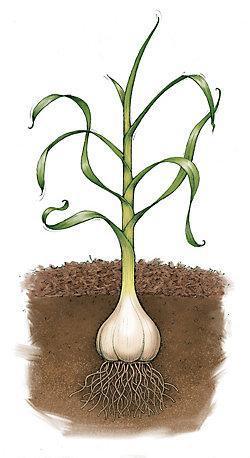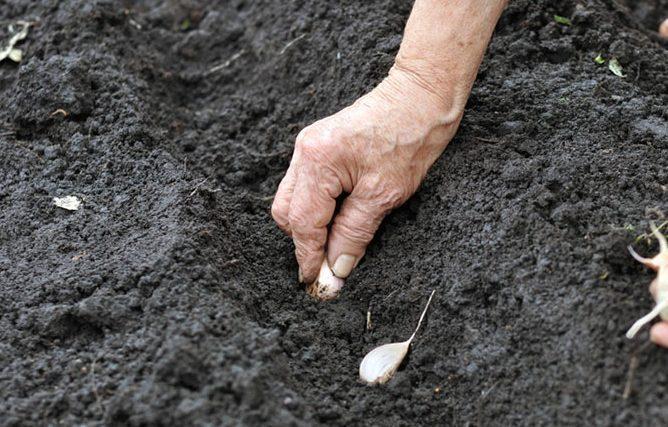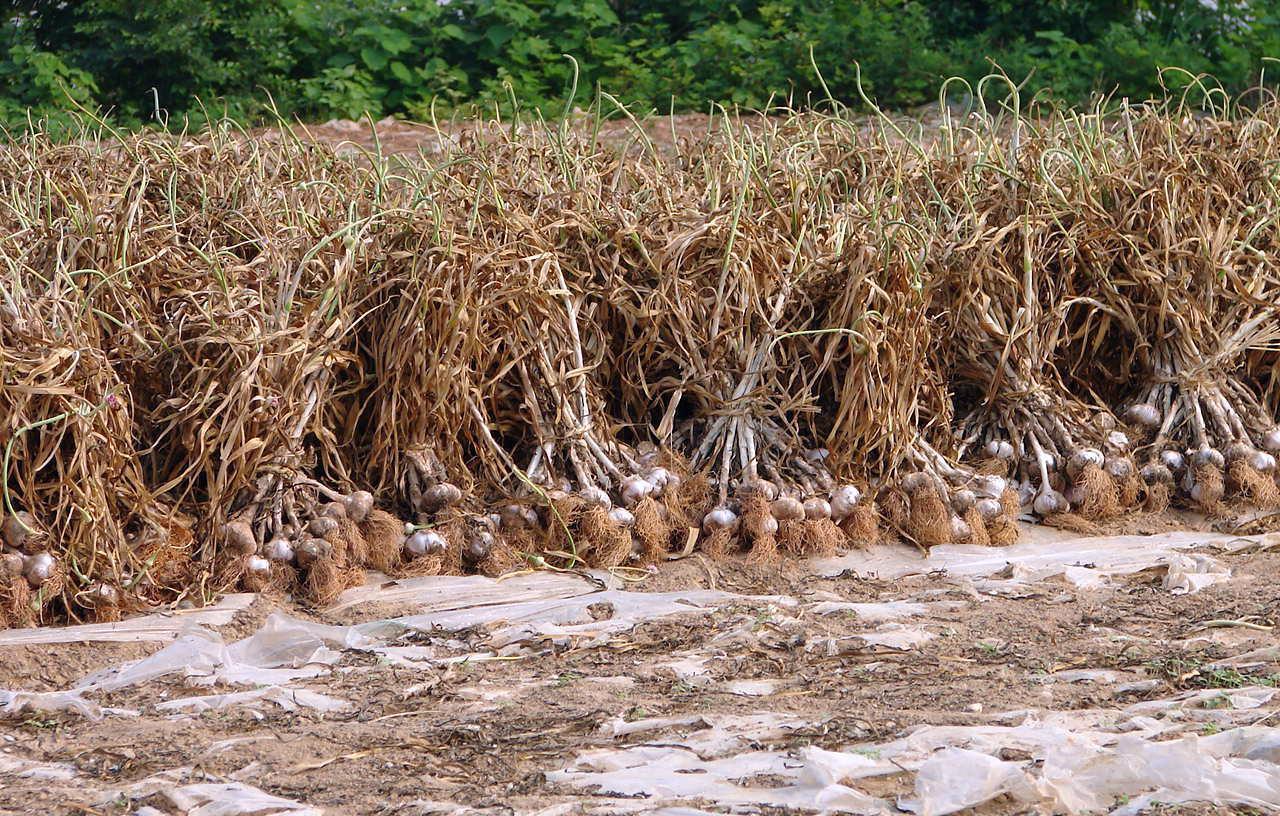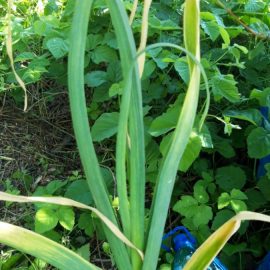Garlic, information about crop management
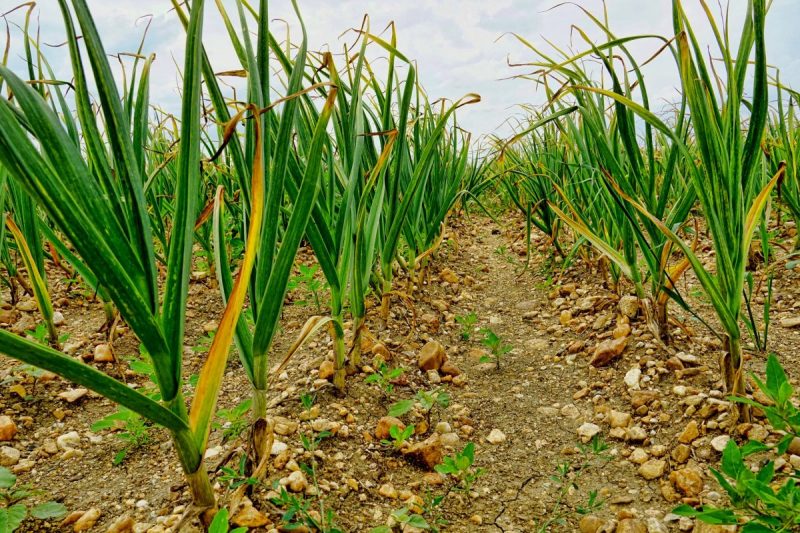
Garlic (Allium sativum ssp. vulgare) is grown for its bulbs and false stem, as well as for the garlic leaves that can be eaten fresh. It is used both as a food or condiment and as a medicine, with many properties. Garlic comes from wild species native to Asia Minor, the Mediterranean Basin, and Egypt, and has been introduced into culture for over 6000 years. Nowadays, it is cultivated all over the world.
The bulb consists of several bulbils (garlic cloves), attached to a common disc (plant stem), wrapped on the outside by parchment-like tunics. Each bulb has its disc, a fleshy leaf, and a sprout attached to the disc. A new garlic plant develops from a bulb. The leaves are linear, curved in a trough shape, and green.
Climate and soil requirements
Garlic has low heat requirements and can be cultivated in autumn or early spring. If well-rooted, it can withstand temperatures as low as -25℃. Because of its poorly developed root system, garlic has high water requirements and requires constant soil moisture, as insufficient moisture prevents bulb growth. This species prefers permeable, light-textured soils rich in organic matter.
Cultivation
Crop rotation
It can be grown after peppers, tomatoes, eggplants, early cabbage, cucumbers, zucchini, and melons. Garlic can return to the same land after at least 3 years. Garlic shouldn’t be grown after peas, beans, or onions, as they have common pests (certain species of nematodes).
Soil preparation
Garlic can be planted in autumn or spring, with autumn soil preparation. Before plowing, you can apply well-decomposed manure, but garlic prefers organic fertilizers applied to the pre-emergent crop. Chemical fertilizers must be applied depending on the soil supply. Before planting, the soil should be tilled and after planting you should apply a pre-emergent herbicide.
Recommended products
-
You can find products on a different store
Change Store -
You can find products on a different store
Change Store -
You can find products on a different store
Change Store -
You can find products on a different store
Change Store -
You can find products on a different store
Change Store -
You can find products on a different store
Change Store -
You can find products on a different store
Change Store -
You can find products on a different store
Change Store -
You can find products on a different store
Change Store -
You can find products on a different store
Change Store -
You can find products on a different store
Change Store -
You can find products on a different store
Change Store -
You can find products on a different store
Change Store -
You can find products on a different store
Change Store -
You can find products on a different store
Change Store -
You can find products on a different store
Change Store -
You can find products on a different store
Change Store -
You can find products on a different store
Change Store -
You can find products on a different store
Change Store -
You can find products on a different store
Change Store -
You can find products on a different store
Change Store -
You can find products on a different store
Change Store -
You can find products on a different store
Change Store -
You can find products on a different store
Change Store
Recommended products
-
You can find products on a different store
Change Store -
You can find products on a different store
Change Store -
You can find products on a different store
Change Store -
You can find products on a different store
Change Store -
You can find products on a different store
Change Store -
You can find products on a different store
Change Store -
You can find products on a different store
Change Store -
You can find products on a different store
Change Store -
You can find products on a different store
Change Store -
You can find products on a different store
Change Store -
You can find products on a different store
Change Store -
You can find products on a different store
Change Store -
You can find products on a different store
Change Store -
You can find products on a different store
Change Store -
You can find products on a different store
Change Store -
You can find products on a different store
Change Store -
You can find products on a different store
Change Store -
You can find products on a different store
Change Store -
You can find products on a different store
Change Store -
You can find products on a different store
Change Store -
You can find products on a different store
Change Store -
You can find products on a different store
Change Store -
You can find products on a different store
Change Store -
You can find products on a different store
Change Store
Planting
Garlic cultivation can be established in autumn (September-October) or spring (beginning of March) by planting cloves. The planting material must be certified, from crops that are not infested with nematodes and kept in low humidity and negative temperature conditions. Planting should be done 25-30 cm between rows and 5-10 cm between plants per row. Planting depth is 6 cm in autumn and 4 cm in spring. The amount of garlic cloves needed for one hectare varies between 800 and 1000 kg. After planting, the crop must be irrigated.
Pest and disease control
It is done by applying approved fungicide or insecticide treatments. To avoid the appearance of diseases or pests resistant to pesticides, it is recommended to alternate products.
Weed control
The soil should be kept loosened and weed-free by hoeing or by applying approved post-emergent herbicides.
Other tips and care works
Successful cultivation requires irrigation to achieve high yields and superior quality. 3-4 waterings can be applied during the bulb growth period, depending on the amount of rainfall.
If garlic starts to form flower stalks, these should be removed to prevent the plant from using resources in this direction.
After plant emergence, you can apply balanced fertilization with chemical or organic-mineral fertilizers. Garlic also reacts well to foliar fertilizers.
Recommended products
-
You can find products on a different store
Change Store -
You can find products on a different store
Change Store -
You can find products on a different store
Change Store -
You can find products on a different store
Change Store -
You can find products on a different store
Change Store -
You can find products on a different store
Change Store -
You can find products on a different store
Change Store -
You can find products on a different store
Change Store -
You can find products on a different store
Change Store -
You can find products on a different store
Change Store -
You can find products on a different store
Change Store -
You can find products on a different store
Change Store -
You can find products on a different store
Change Store -
You can find products on a different store
Change Store -
You can find products on a different store
Change Store -
You can find products on a different store
Change Store -
You can find products on a different store
Change Store -
You can find products on a different store
Change Store -
You can find products on a different store
Change Store -
You can find products on a different store
Change Store -
You can find products on a different store
Change Store -
You can find products on a different store
Change Store -
You can find products on a different store
Change Store -
You can find products on a different store
Change Store
Harvesting
Garlic can be harvested when the leaves begin to dry. Calendarically, the harvesting season is between July and August. The plants must be harvested carefully so as not to destroy the tunics that cover the bulbs, and after harvesting the garlic must be left for 4-6 days in the field to dry.
After drying, the bulbs should be conditioned and stored in dry, well-ventilated rooms at temperatures of about 6℃. For long-term storage, the recommended temperature range is 0 to 3℃. It can be harvested in spring for fresh consumption (green garlic).
Tips for growing green garlic
Green garlic is grown in winter in protected areas and in spring in the field. Cultivation in the field is usually started in autumn (September-October) or early spring.
The planting material must be certified from nematode-free crops. If planted in spring, the planting material should be kept at temperatures between 0 and 3℃ in dry, well-ventilated rooms. As a planting scheme, the same can be used for the bulb crop. After planting, the crop must be irrigated to encourage rooting. Mentain temperatures between 18 and 25℃ and pay special attention to the daily aeration of the plot.














































































































































































































































































































































































































































